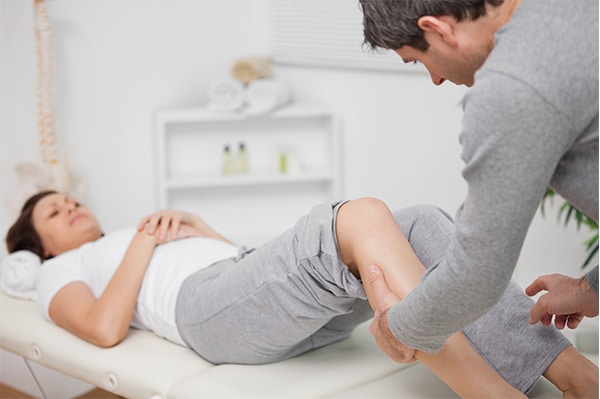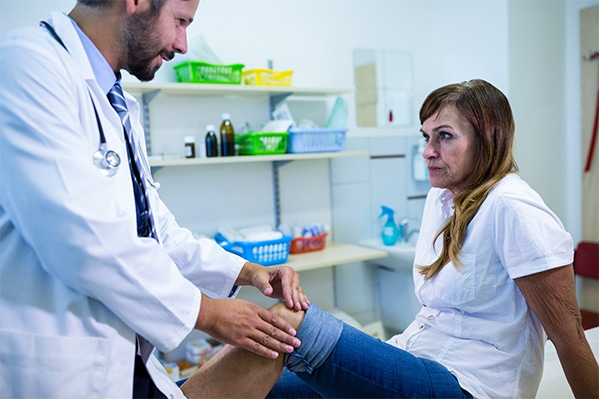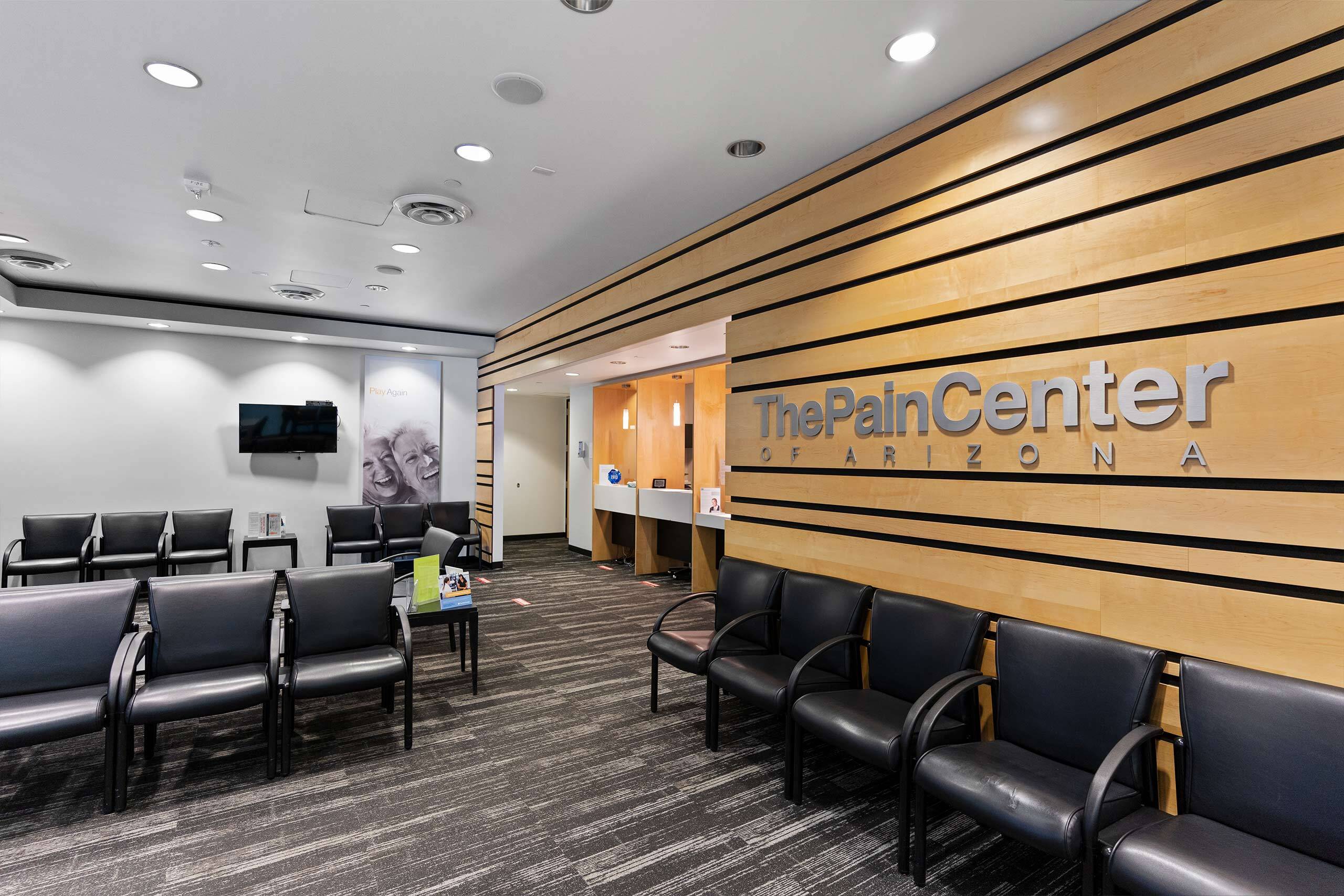Leg Pain Relief
Do you suffer from leg pain? Leg pain is a common condition that may develop from natural wear and tear, overuse, injury or an underlying condition. Patients may experience pain for several days, weeks or months, depending upon the cause and severity. Leg pain may be described as mild, moderate or severe, and can occur in one leg or in both legs. Depending on the cause of your leg pain, you may experience discomfort while you are active or while you are lying down.
If you feel acute or chronic pain in the leg, calf, thigh or lower back, there are things you can do to help reduce your discomfort. Leg pain can originate in the bones, connective tissues, blood vessels, nerves or skin. If you have severe or long-lasting leg pain, it can have a negative impact on your quality of life.

Causes of Leg Pain
What causes leg pain and how can you find relief? The answer depends on the underlying condition that creates your symptoms. Chronic or severe leg pain can be caused by a number of common conditions, such as:
- Intense exercise or overuse (muscle aches)
- Blood clot (deep vein thrombosis) or peripheral artery disease
- Injury
- Muscle, ligament or tendon strains
- Fibromyalgia
- Skeletal structure irregularities
- Arthritis
- Poor circulation or cardiac disorders
- Nerve damage
- Herniated disc or other lower spine condition
- Sciatica from spinal disc disease
- Diabetic neuropathy
- Osteoporosis
- Other underlying conditions

Leg Pain Symptoms and Diagnosis
Be sure to inform your doctor of all your symptoms. Some symptoms of leg pain can include:
- Pain in one or both legs, with or without back pain
- Foot pain
- Pain that comes on suddenly or comes and goes
- Redness or discoloration of the skin on the leg
- Swelling in the leg, ankle or calf
- Distended veins
- Weakness
- Leg skin that is warm to the touch
- Itching or throbbing skin
- Pain that worsens when walking or exercising
- Sciatica leg pain or pain that radiates down the back of the leg toward the feet
- General leg stiffness or morning stiffness
- Numbness, tingling or throbbing
- Muscle pain / muscle aches
- Aching with or without fever
- Tenderness
- Burning pain
- Reduced range of motion
- Change in how you walk or move due to pain (limping)
- Muscle cramps
- Achilles pain in your lower calf
Be sure to get medical help right away if you have trouble breathing, dizziness or chest pain along with leg discomfort, as this could be a sign of a blood clot.
To diagnose the cause of your pain, your doctor will ask you questions about your health and family history, and do a physical examination. Other tests that can help diagnose the source of your pain include X-rays, MRI scan, CT scan and blood tests. It is important that your condition is properly diagnosed so that you can receive the most effective and appropriate treatment.

How to Treat Leg Pain
How can you ease the discomfort of leg pain? Your treatment options depend on the underlying cause and severity of your leg pain.
Treatment may start with conservative therapies, such as over-the-counter aspirin, acetaminophen, or ibuprofen. These nonprescription medications can be effective for certain types of leg pain when taken according to instructions.
You may also consider home care such as drinking plenty of water to reduce leg cramps. Stretching and massage can also help. You may also try using heating or cold packs, taking warm baths or showers, and resting your legs. Be sure to wear shoes that support the arch in your foot and are comfortable to wear. Elevate your leg when you sit or lie down.
The pain management specialists at The Pain Center may also recommend the following interventional pain therapies to reduce your leg pain:
- Prescription medications / medication management
- Topical agents (creams)
- Injections such as steroid medications
- Spinal cord stimulation
- Nerve blocks
- Biofeedback
- Physical therapy (can include exercises, losing weight if necessary, heat and cold therapy, electrical nerve stimulation)
- Alternative treatments such as acupuncture, chiropractic adjustments and/or massage
Some of the interventional medical therapies we provide at The Pain Center include:
Medication Management
The pain specialist will prescribe and regulate the medication that you use to help control your pain. The pain management specialist will provide you with the knowledge you need to take your medications properly.
The Pain Center takes a conservative approach with medication management. We try to limit prescription medications to help avoid dependence.
Steroid Injections
One option for treating pain is injections of dexamethasone, a steroid that helps reduce pain and inflammation. This can be very effective for arthritis, rheumatoid arthritis and osteoarthritis.
Nerve Blocks
A nerve block is an injection therapy that reduces pain caused by a nerve(s). This can help treat peripheral neuropathy, diabetic peripheral neuropathy and neuropathic pain. This procedure injects a combination of local anesthetic agents around the peripheral nerve branches for optimal pain relief. Peripheral nerve blocks may provide relief that lasts from a few weeks to a few months, depending on the patient’s condition.
Spinal Cord Stimulation
Spinal cord stimulation is an FDA-approved, minimally invasive procedure that requires the implantation of a nerve stimulation device. This treatment delivers low-voltage electrical currents to areas of the spine, ultimately reducing pain signals caused by chronic pain. Patients living with chronic back or leg pain, who have not responded to conservative treatments for at least six months, may be candidates for this procedure. A trial device is implanted before a permanent device is considered.

When Further Leg Pain Treatment is Required
Based on the underlying condition, further treatments may be required. If there is something that can be addressed by another type of specialist, we will refer you to the appropriate specialty doctor.
TPC Treatments
TPC Spine Stim
TPC Spine Stim is a minimally invasive spinal cord stimulation solution for chronic refractory pain conditions that have failed conservative therapies.
Spinal cord stimulation (SCS) is a neuromodulation therapy for treating medically refractory chronic pain. In SCS, an implanted pulse generator produces electrical signals conveyed through electrode arrays located in the region of the spinal cord.
TPC Spine Fuse
TPC Spine Fuse targets spinal degeneration, usually brought on by stenosis, spondylolisthesis, and related conditions. It works to alleviate pain due to pressure on the spinal cord and instability that causes painful movements of the vertebrate.
In this procedure, a small incision goes into the back under live X-ray guidance. A device is placed between the spinous processes that fuse the segment. This gives the back stability, where the bones shift forward and backward. Our procedure can also be done through alternative approaches (a posterior, oblique, or lateral approach) depending on each individual’s needs.
TPC Spine Lift
TPC Spine Lift is a spinal decompression treatment to relieve spinal nerve pressure pain. This procedure is designed to aid patients suffering from chronic pain due to spinal stenosis and related conditions.
Our procedure uses the Vertiflex technique, lifting the space where the lumbar vertebrae are narrowing or bulging (often resulting from spinal stenosis). This process is done under a live X-ray as guidance, placing a small device that opens up the pressure area.
TPC Sacral Fuse
TPC Sacral Fuse provides stability to the joints of patients with sacroiliac joint dysfunction. This condition can cause pain with too little or too much joint movement.
Under live X-ray guidance, a small device is placed into the sacroiliac joint, fusing the joint. Fusing the joint creates better stability, targeting pain caused by movement and instability.
Commonly Asked Questions about Leg Pain
Are there any homecare therapies for treating leg pain?
There are many homecare therapies you can use to help with leg pain. You might try over-the-counter pain relievers such as Tylenol or Advil (use as directed), rest, massage, elevation of the leg(s), cold or hot packs, and appropriate stretching.
I have diabetes. Is this causing the pain in my legs?
Some people with poorly controlled diabetes develop diabetic neuropathy, which causes damage to nerves in the legs and feet. This can give them a tingling sensation or pain. Diabetes can also cause narrowing of arteries in the legs, which can in turn cause when the person is exercising because not enough oxygen is being delivered.
I have been having back problems. Could my leg pain be related to my back?
It is possible for back problems to cause pain in the legs. People with arthritis or ruptured or bulging spinal discs can develop sciatica. Sciatica is a pain, numbness or tingling sensation stemming from the sciatic nerve, which radiates down the leg toward the feet.


Get the care you need within 24 hours*
We know when you’re looking for relief for your chronic pain, you can’t wait any longer than you already have. This is why we can schedule you with an appointment within 24 hours at most of our pain centers across the Valley, so you can start your journey to life-long pain relief as soon as tomorrow.



